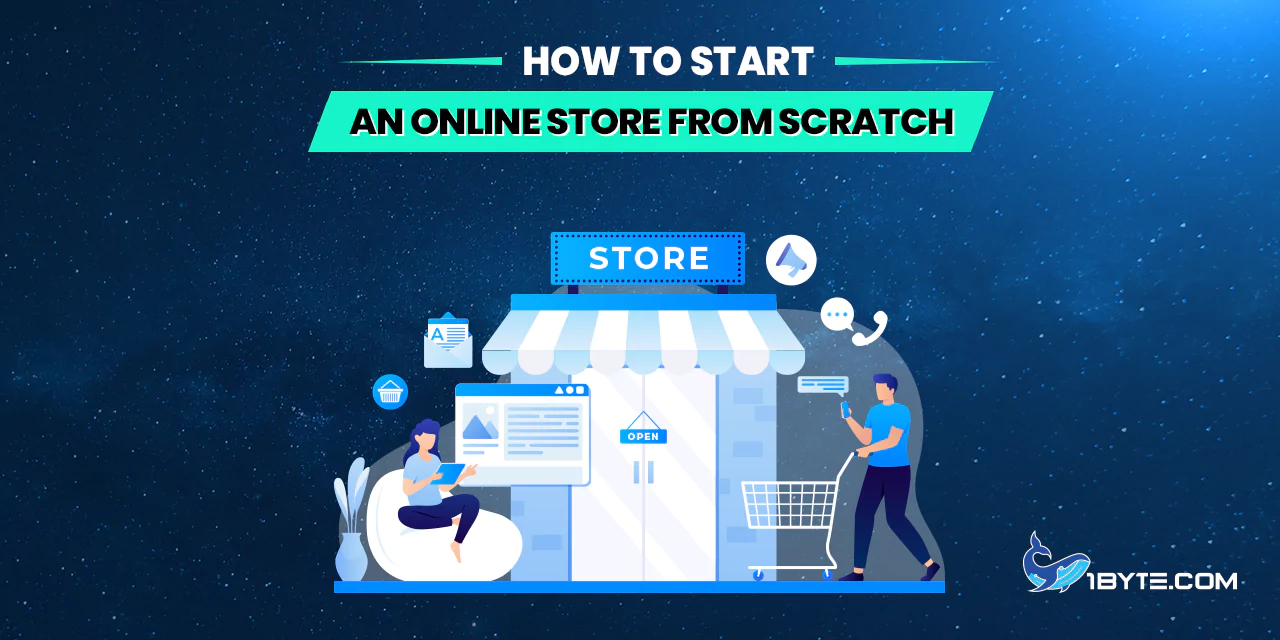Starting an online store from scratch may seem like a daunting task, but in today’s digital age, it’s a venture that holds immense potential. If you’ve ever wondered how to start an online store and turn your e-commerce dreams into reality, you’re in the right place. This article from 1Byte will guide you through the essential steps, providing clear and straightforward instructions to help you launch your very own online store. Whether you’re a budding entrepreneur or an established business looking to expand online, this comprehensive guide will set you on the path to e-commerce success. So, let’s dive in and explore the key elements of starting your online store journey.
Choose Your Niche
When embarking on the journey of starting an online store, one of the most critical decisions you’ll make is choosing your niche. Your niche defines your store’s identity and sets the stage for your entire e-commerce venture. In this section, we’ll explore how to select the perfect niche for your online store. Understanding the significance of this choice and following the right steps will lead you to a niche that aligns with your interests, target audience, and business goals. So, let’s delve into the process of choosing the ideal niche to ensure the success of your online store from the ground up.
FURTHER READING: |
| 1. 5 Ecommerce Business Plan Templates to Craft Your Success |
| 2. How to Investing in Websites: A Step-by-step Guide |
| 3. Do I Need A Website When I Already Have A Facebook Page? |
The importance of selecting the right niche for your online store

Selecting the right niche for your online store is a pivotal decision that can significantly impact your e-commerce journey. Here’s why it holds such immense importance:
- Avoiding Competition with Mega Retailers: Direct competition with major online retailers like Amazon can be daunting. These “Mega-Retailers” possess billion-dollar advertising budgets, making it essential to identify a product line that often goes unnoticed by these giants.
- Profitability: Niche e-commerce stores typically don’t generate numerous daily sales. Therefore, it’s advisable to focus on higher-priced products, where each order can yield a substantial profit of $50 or more.
- Targeted Audience: Opting for a micro-niche enables you to rank your content for related keywords more effectively. With less competition, you can reach a more specific and interested audience.
- Customer Focus: Running a niche store allows you to prioritize customer satisfaction rather than constantly searching for the next trending product.
- Sustainability: Even if your chosen niche is relatively broad, it’s essential to select one that promises long-term commercial viability.
Keep in mind that choosing the right niche requires thorough research, meticulous planning, and careful testing. This step is critical, as no amount of e-commerce training can compensate for an ill-fitting niche.
FURTHER READING: |
| 1. WordPress Tutorial: 6-Step Guide to Create Your First Website |
| 2. Top 10 AI Website Builders You Should Know |
| 3. 10 Free WordPress Themes to Transform Your Website's Aesthetics |
Tips on how to research and choose a profitable niche
Here are some valuable tips to assist you in researching and selecting a profitable niche for your online store:
- Examine Your Interests and Strengths: Start by reflecting on your personal interests and strengths. Consider activities you genuinely enjoy outside of work, or if you have hobbies you’re passionate about. For instance, if you have a knack for game design, you might discover a niche within the gaming industry.
- Research the Chosen Niche: Dive into comprehensive market research to understand the dynamics of your chosen niche. Analyze the advertising and branding strategies employed by similar businesses in that niche. Explore ways to set your offerings apart and leverage your creativity for a competitive edge.
- Analyze Market Trends: Keep an eye out for niches that are experiencing a surge in popularity and exhibit significant potential for profitability.
- Identify Market Gaps and Problems: Successful niche businesses often fill unique needs or address specific problems within a defined market segment. Look for opportunities where you can provide exceptional value.
- Evaluate the Market Value: Assess the overall market value of your chosen niche. This evaluation will provide insights into the potential profitability of your venture.
- Validate the Niche: Before committing, test your niche idea in the real world. Determine if there is genuine interest from your target audience and if they are willing to pay for your products or services.
Selecting a niche aligned with your passion can enhance your chances of building a thriving business. Additionally, prioritize niches with long-term growth potential rather than solely focusing on short-lived trends.
Plan Your Business
Starting an online store from scratch requires careful planning and strategic decision-making. In this section, we’ll guide you through the essential steps to plan your online business effectively. Whether you’re venturing into e-commerce for the first time or looking to refine your existing store, these insights will help you lay a strong foundation for success. Let’s dive into the key aspects of planning your online store.
The necessity of creating a solid business plan for an online store

A well-structured business plan is the cornerstone of a successful online store. This section will highlight the necessity of creating a solid business plan and explain its various benefits in detail. Whether you’re a novice entrepreneur or an experienced e-commerce enthusiast, understanding the importance of this foundational document is crucial for the growth and sustainability of your online business.
- Defining Your Vision:
A business plan helps you articulate your business idea, identify your target market, and establish your monthly and quarterly sales goals. It provides a roadmap for your business, outlining your vision, mission, and how your business will operate.
- Financial Planning:
It helps you determine the startup costs, set up an order fulfillment process, and establish your online presence. It also helps you set realistic sales expectations and ensure that the revenue you bring in will be enough to cover costs and generate some profit.
- Identifying Potential Roadblocks:
A business plan can help you identify potential challenges and devise strategies to overcome them.
- Attracting Investors:
If you’re seeking external funding, a well-crafted business plan can help attract investors. It provides investors with a clear picture of your business, including your market analysis, financial projections, and marketing strategy.
- Long-term Success:
A business plan increases the likelihood of long-term e-commerce success by keeping you organized and focused.
A good business plan is not just a tool for starting a business, but also for running one. It should be a living document, updated as your business grows and changes.
The key components of a business plan for an online store
A well-structured business plan for an online store is composed of several key components that collectively form a comprehensive strategy for your e-commerce venture. Understanding these components is essential for creating a roadmap to success. Here’s a breakdown of the key elements typically found in a business plan for an online store:
- Executive Summary:
This section provides a concise yet informative overview of your business plan. It offers readers a snapshot of your company’s profile and its overarching goals.
- Company Description:
In this segment, you’ll provide essential details about your business, including its legal entity, brand name, business type, ownership structure, key personnel, web domain, and any other pertinent information.
- Market Analysis:
Market analysis involves a thorough examination of your target market and a comprehensive assessment of your competitors. It’s a critical step in understanding your niche and positioning your online store effectively.
- Products:
This section delves into the specifics of the products you intend to sell through your online store. Detailed descriptions of your product offerings, including their unique selling points, should be included here.
- Marketing Plan:
Your marketing plan outlines the strategies and tactics you’ll employ to attract and retain customers. Effective marketing is key to driving traffic to your online store and converting visitors into paying customers.
- Operations:
The operations section provides an insight into how your online store will function on a day-to-day basis. This includes details about inventory management, order processing, customer service, and other operational processes.
- Financial Plan:
Your financial plan encompasses revenue projections, expense forecasts, and profitability estimates. It’s a crucial part of your business plan, as it helps you gauge the financial viability of your online store.
- Appendix:
The appendix is a repository for any additional supporting documents that enhance your business plan. This can include market research data, financial spreadsheets, product catalogs, and more.
Understanding these key components and how they fit together is fundamental to crafting a comprehensive and effective business plan for your online store. Each element plays a vital role in guiding your e-commerce venture toward success.
Register Your Domain and Website
In the process of learning how to start an online store from scratch, one of the fundamental steps you’ll encounter is registering your domain and securing a website for your e-commerce business. These actions are pivotal as they lay the foundation for your online business presence and its accessibility to potential customers. In this section, we’ll explore the importance of domain registration and hosting, guiding you through the process with clarity and simplicity. Let’s dive into the essential steps to establish your online store’s digital home.
The steps to register a domain name and select a hosting provider for your online store

Registering a domain name and selecting a hosting provider for your online store involves several straightforward steps. Here’s a general guide to help you navigate the process with ease:
Step 1: Choose Your Domain Name
- Start by brainstorming a unique and relevant name for your online store that aligns with your brand identity. Ensure it’s easy to remember, spell, and type.
- Utilize a domain name search tool, commonly available on domain registrar websites, to check the availability of your chosen domain name. If it’s already taken, these tools often suggest similar alternatives.
- Consider various domain extensions, such as .com, .net, .store, .shop, or .biz, based on availability and relevance.
Step 2: Register Your Domain Name
- Select a reputable domain registrar, like 1Byte, GoDaddy, Namecheap, or Bluehost.
- Visit the chosen registrar’s website, search for your desired domain name, and follow the registration steps. This typically involves providing contact information and making a payment.
- Think about opting for domain privacy protection to keep your personal information hidden from the public WHOIS database.
Step 3: Select a Hosting Provider
- Assess your website’s needs in terms of bandwidth, storage, security, and scalability based on your online store’s size and expected traffic.
- Research hosting providers known for their excellent uptime, customer support, and relevant features. Popular choices for e-commerce include 1Byte, Shopify, Bluehost, HostGator, and SiteGround.
- Ensure the hosting provider supports e-commerce platforms like WooCommerce (for WordPress), offers SSL certificates for secure transactions, and provides straightforward shopping cart installation.
Step 4: Purchase a Hosting Plan
- Choose a hosting plan that aligns with your budget and technical requirements. Many providers offer different tiers based on website size and expected traffic.
- Register and purchase your selected hosting plan through the provider’s website. During registration, you can often connect your previously registered domain name.
Step 5: Set Up Your Website
- If you’re using WordPress, install an e-commerce plugin like WooCommerce. Specialized e-commerce hosts like Shopify have their setup processes.
- Customize your store’s design using themes and add your products, descriptions, prices, and images.
- Configure payment gateways (e.g., PayPal, Stripe) and define shipping rates and zones.
Step 6: Test and Launch
- Thoroughly test your store before going live. Check navigation, the transaction process, mobile responsiveness, and loading speed.
- Once everything is set up and tested, you’re ready to launch your online store.
Post-Launch
- Regularly maintain your website by updating products and security features.
- Implement digital marketing strategies to attract customers to your store and drive online sales.
Market Your Store
Marketing your online store is crucial to reach your target audience and generate sales. In this final section, we’ll explore effective strategies and techniques to promote your online store successfully. These strategies will help you increase your store’s visibility, attract potential customers, and ultimately boost your online sales. Let’s delve into the world of online store marketing to maximize your success.
Digital marketing strategies for promoting your online store

To effectively promote your online store, it’s essential to implement a strategic approach to digital marketing. Here are some key strategies to consider:
- Search Engine Optimization (SEO): Start by optimizing your website for search engines. This involves conducting thorough keyword research to identify the terms and phrases your potential customers are searching for. Incorporate these keywords naturally into your website’s content, product descriptions, and meta tags. Focus on providing high-quality content, ensuring a seamless user experience, optimizing your site for mobile devices, and building authoritative backlinks to improve your website’s visibility in search engine results.
- Content Marketing: Create and share valuable content that resonates with your target audience. This can include blog posts, informative videos, engaging infographics, and insightful podcasts. By consistently producing relevant and informative content, you not only establish your brand as an authority in your niche but also enhance your website’s SEO.
- Social Media Marketing: Leverage popular social media platforms such as Facebook, Instagram, Twitter, and Pinterest to connect with your audience. Regularly post engaging content, interact with your followers, and consider using social media advertising to expand your reach to a broader audience.
- Email Marketing: Collect email addresses from your website visitors and customers, and then use email marketing to nurture these leads. Send newsletters, promotional offers, and personalized content to keep your audience engaged and informed. Email marketing is highly effective for customer retention and driving repeat sales.
- Pay-Per-Click (PPC) Advertising: Invest in PPC advertising campaigns using platforms like Google Ads and Bing Ads. This strategy allows you to target specific keywords and demographics, driving highly relevant traffic to your online store. Additionally, consider utilizing PPC on social media platforms like Facebook and Instagram to reach a broader audience.
- Influencer Marketing: Collaborate with influencers who have a substantial following within your niche. Influencers can effectively promote your products to their engaged audience, increasing your brand’s visibility and credibility.
- Affiliate Marketing: Implement an affiliate program where partners promote your products in exchange for a commission on sales. This approach can significantly expand your reach and drive sales through an extended network of affiliates.
- Retargeting Ads: Utilize retargeting ads to re-engage visitors who have previously interacted with your website but didn’t make a purchase. These ads serve as gentle reminders and encourage potential customers to return to your store.
- Video Marketing: Harness the power of video by creating product demonstrations, how-to guides, or behind-the-scenes glimpses of your brand. Platforms like YouTube, TikTok, and Instagram Reels offer excellent opportunities for video marketing.
- Customer Reviews and Testimonials: Encourage satisfied customers to leave reviews and share their experiences with your products. Positive reviews can be incorporated into your marketing efforts and play a crucial role in building trust with potential customers.
- Google My Business: If your online store has a physical location or local presence, ensure that you list your business on Google My Business. This helps local customers discover your store and provides essential information about your location and offerings.
- Mobile Optimization: With an increasing number of consumers shopping on mobile devices, it’s imperative to have a mobile-friendly website. A mobile-optimized site enhances user experience, leading to improved conversions.
- Analytics and Measurement: Make use of tools like Google Analytics to track your website’s performance. Analyzing data helps you gain a better understanding of your audience, allowing you to optimize your marketing strategies for maximum effectiveness.
Remember, the most effective digital marketing strategy for your online store will depend on your target audience, budget, and specific business goals. Combining several of these strategies can provide a comprehensive and successful approach to promoting your online store.
Leverage 1Byte’s strong cloud computing expertise to boost your business in a big way
1Byte provides complete domain registration services that include dedicated support staff, educated customer care, reasonable costs, as well as a domain price search tool.
Elevate your online security with 1Byte's SSL Service. Unparalleled protection, seamless integration, and peace of mind for your digital journey.
No matter the cloud server package you pick, you can rely on 1Byte for dependability, privacy, security, and a stress-free experience that is essential for successful businesses.
Choosing us as your shared hosting provider allows you to get excellent value for your money while enjoying the same level of quality and functionality as more expensive options.
Through highly flexible programs, 1Byte's cutting-edge cloud hosting gives great solutions to small and medium-sized businesses faster, more securely, and at reduced costs.
Stay ahead of the competition with 1Byte's innovative WordPress hosting services. Our feature-rich plans and unmatched reliability ensure your website stands out and delivers an unforgettable user experience.
As an official AWS Partner, one of our primary responsibilities is to assist businesses in modernizing their operations and make the most of their journeys to the cloud with AWS.
Conclusion
In the ever-evolving world of e-commerce, adaptability and a customer-centric approach are vital. By staying informed about industry trends, monitoring performance through analytics, and responding to changing consumer preferences, online store owners can thrive in the competitive online marketplace.
So, whether you’re passionate about a particular niche or have a unique product idea, embarking on the journey of starting an online store is within your reach. With the right guidance and a commitment to learning and adapting, you can turn your online store into a successful and thriving business. Get started today, and watch your online store flourish in the digital landscape.

